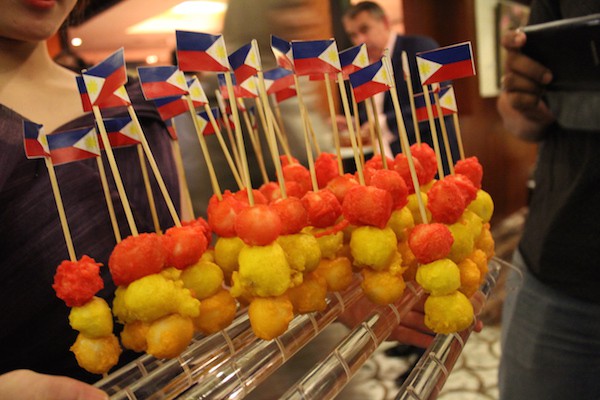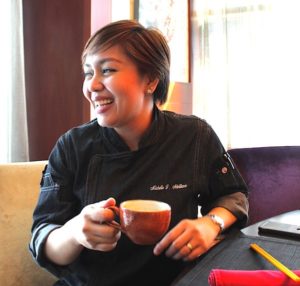Qatar Eating had a cosy chat with Chef Michelle Adrillana who is in Doha with a specially curated menu that she will be cooking at Hwang restaurant for the Filipino Food Fiesta!
Held in cooperation with the Philippines Embassy and InterContinental Doha The City, the event celebrates the flavours and diversity of Filipino Food. It will include Filipino favourites such as Adobo, Sisig, Pancit and Halo Halo in a special a la carte menu until 25th October 2016.

The Filipino Food Fiesta promotion is on until October 25th. All Philippine nationals receive 20% off their meal with proof of ID. For more information and bookings call +974 4015 8888.
Chef Michelle Adrillana talks Filipino Food!
Taking a moment to relax from the busy kitchen Chef Michelle discusses her fusion cooking style, her Filipino food heritage, and her love for the Middle East.
Welcome to Doha Chef Michelle. Can you tell us why did you become a chef?
Ten years ago I was a professional singer and I did not know how to cook, not even the dog liked what I would cook – it’s a true story!
When I was still singing with my rhythm section, we had a dog called Tango, and every time I would try to feed him something that I had cooked that dog would step back and whimper. It was so embarrassing but I thought one day I will show you I can cook.
I had to stop singing due to throat nodules so I thought that was a sign to find something else to do. I fell in love with the composure of Nigella Lawson, and I wanted to put together her appeal with the actions of Gordon Ramsay to become a strong chef. I thought if I could do that then I would be okay.

Because everybody in my family can cook – even my uncles and cousins – I always knew what I was eating. Even if I didn’t know how to execute it I know what was in it. I went to a diverse culinary school where we were trained the French way, although they were slave drivers I didn’t want to stop!
What is your earliest food memory?
My grandmother has Spanish, Chinese and Filipino blood and she is the type who cooks everything from scratch. When I was a child there were no gadgets or things so I would help my grandmother whilst sitting in the backyard. She would ask me to remove the fibres from the ends of the beans and the grains from the rice.
But I didn’t know that I would be travelling the road to culinary school. I never imagined I would be a chef, because I was really a disaster. I didn’t know how to cook an egg – I would have to wear a jacket and eye glasses because I was so scared!

Years ago I had thought I would write, travel and cook for the whole world – and now I am doing it!
Can you tell us about your involvement with the Filipino Food Fiesta project?
We went to Sydney last year, with the motto “It’s more Fun in the Philippines”. The government was keen to promote the Philippines through cultural diplomacy, and what best way to promote the country than through the universal language of food. We also visited Guangzhou in China last summer, when they were holding one of the world’s biggest trade fairs, which was perfect timing.
Compared to our neighbouring countries we are left behind. People wonder what is Filipino cuisine. Everybody knows Indonesian, Thai, Korean, Indian, Japanese, but we are left behind. As my training was French cuisine and western cooking, I thought why not apply the western techniques to Filipino cooking.
Most people are not very found of the cuisine because it is swimming in oil, but I believe if you prepare it really well the global market would be ready to accept. Antony Bourdain raves about it, Nigella Lawson just came recently and Anna Olsen was there as well. I know that Filipino cuisine will be the next big thing!

What challenges have experienced when bringing the project to Qatar?
Pork was the biggest challenge. I had to give a modern twist to some of the dishes in order to appeal to the Middle East market. Normally in the Philippines we prepare Sisig with pork, that has a lot of fat in the crackling. So we have to find a way to make it work because it should be crispy and gelatinous.

So I thought of using oxtail instead, there is beef cheeks and beef brisket, so there should be enough layers of fat in there. You still need to use that layer of fat which has to come from somewhere, but of course the taste will be very different although we are using spices and other ingredients to keep the heritage of the food, so it wouldn’t be that far from the original flavour.
With my style of cooking I am very open. I like Middle Eastern food – if I was ever going to be a vegetarian I could eat the mezze platter the whole day. I keep an open mind and try to absorb everything from my travels and the people that I meet. I have a dish called Tinola Martini which is chicken soup with bones cooked in ginger broth. To elevate the dish I take away the bones, cook ground chicken with vegetables and poach it in a ginger broth, and then put it in a martini glass with the broth.
What ingredients do you need in your pantry to cook Filipino cuisine?
The Philippines has been colonised for three centuries by the Spaniards. This has had an influence on Filipino cuisine, with pork as a staple – however you can replaces this with other proteins like chicken. We also have bay leaf, black peppercorns, vinegar, and annatto seeds.
 We also have to have vegetable oil because we like deep fried food. We use our own fish sauce, soy sauce, fish paste or shrimp paste – these are the flavouring ingredients we use as we don’t use salt. We use coconut cream and coconut milk.
We also have to have vegetable oil because we like deep fried food. We use our own fish sauce, soy sauce, fish paste or shrimp paste – these are the flavouring ingredients we use as we don’t use salt. We use coconut cream and coconut milk.
We also have a particular green chilli which is not spicy, but it has its mild and distinct flavour. We use birds eye chilis too, which are very spicy. And because we like to eat sinful foods we also use crab fat.
What dishes represent Filipino cuisine?
It seems the whole world knows about Adobo! There is so much more to Filipino cuisine than adobo, but I understand the charm. How can you go wrong with something that is stewed in vinegar, soy sauce, and fish sauce with bay leaves, whole peppercorns, and a lot of garlic. It’s beautiful in its simplicity – slow cooked and simmered, it just allows the flavours to seep into the meat.
Adobo has lots of variations – you can make adobo with coconut cream, adobo with chillies, beef adobo with rosemary. I have adobo using balsamic vinegar instead of the usual vinegar – it is still adobo, it still keeps its character, it is very versatile. We will be preparing an adobo with chicken but the taste will still be Filipino. Of course pork cannot be compared to chicken, or beef to pork but I would like the Middle Eastern people to open their hearts to our food, and to know that it is not all about pork. It is about the flavours, and you can enjoy our food.
We also have Sinigang which is like Tom Yum Goong, and you can cook it in so many ways as well, with beef, pork, or seafood.It is a little spicy and depending on which region you come from the taste varies. Just like a curry you can cook it with seafood – I wanted it to have a richer character to it, so I sauté prawns with crab fat which gives it a bright orange colour.
The Kaldereta is a tomato stew with potatoes, carrots, green peas and sausages. It also has cheese – that’s the Filipino thing about it, it’s not a speciality cheese, but local processed cheese. Instead of beef for the Kaldereta I am thinking of using a lamb shank to make it richer for the a la carte menu, which will be very interesting for the palate.

Bangus is milk fish, our national fish, which is stewed in vinegar, ginger and garlic – it is very lovely in its simplicity. We have the Bulalo which is beef bone marrow slow cooked in a clear broth with vegetables. It has a layer of sweetness and is simple comfort food with a clean taste. The Pinakbet is an assorted vegetable dish cooked with shrimp paste and green chilis.

Our Halo Halo is a crowd pleaser dessert. It has something similar to plantain bananas, and sweet potatoes, red beans, and coconut. Then there is shaved ice, evaporated milk – which is another local flavour – and it is topped with purple yam ice cream.
Can this informal sharing-style be refined for gourmet restaurant dining?
I am trying to bring the world on the plate. It is my own cooking style, as in every Filipino household they will say that is not how my mom prepared Adobo, or that is not how we cook Sinigang. Everybody will have their own taste, but I would say that Filipino food is already ready to take on the world.
I love Indian food, but it is not fantastically presented, yet they were able to bring it to fine dining. With Filipino food we just need to remove the bones, and use the proper cut and techniques. But the flavour doesn’t have to go. Previously I have made a fusion of Filipino and Japanese food with Kaldereta Ramen, which had a spicy miso base combine with Kaldereta and it was very hearty.
The global culinary scene in the Philippines is changing really fast with a lot of restaurants mushrooming all over the place. The only mistake of chefs, just like me when I was first beginning, is that we don’t like to cook Filipino food. I have learnt to embrace my roots and where I came from so I was able to put my heart into the traditional Filipino recipes. If you are presenting fusion dishes then you have to ensure that the flavours are still there; it has to still be Filipino ingredients with a modern flavour.
What advice would you give to aspiring chefs?
The Filipinos have very critical palates – we are the worst critics, and we are never satisfied with things. We always have something to say, maybe it is good but it needs a dash of this or that. So as a chef you need to keep advancing your skills.
You have to keep an open mind, and you have to accept that you are not always the best. There will always be somebody better than you, but that the beginning of your improvement.
How are you finding your experience in Qatar?
I was able to visit Souq Waqif, and I saw the camels there and walked around the place. I am very interested in the Middle Eastern culture – the smell of the spices, the music, the aroma of the oud, and the beautiful ladies walking in black and the men in white, it’s very exotic.










